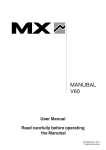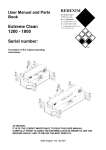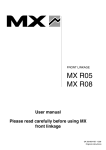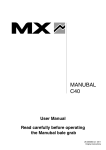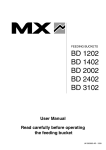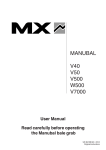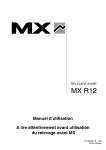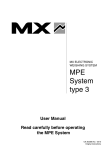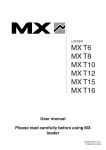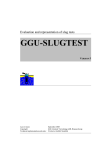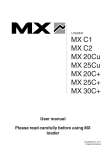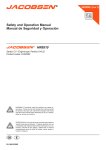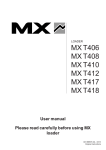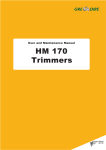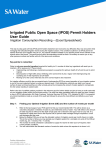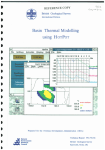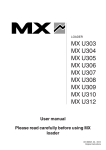Download R12 linkage instructions
Transcript
FRONT LINKAGE MX R12 User Manual Read carefully before operating the MX front linkage UK 364001 AA - 1209 Original instructions Dear users, Thanks you for confidence in our product. We are sure it will give you full satisfaction. By taking a few minutes to read this manual, you will be able to obtain the best results from your MX front linkage, extend its lifespan and work in complete safety. The front linkage user manual is a very important document, please keep it with you in order to be able to use it if required. Leave it available to any other user and give it to the next owner of this front linkage. Pictures and technical information included in this document may not correspond precisely to your front linkage; but the working conditions will be the same. TABLE OF CONTENTS Page 1. SAFETY RULES 5 2. OPERATING REQUIREMENTS 6 3. SAFETY STICKERS 7 4. IDENTIFICATION PLATE 7 5. DESCRIPTION 8 6. SETTING FRONT LINKAGE TO OPERATING POSITION 9 7. HITCHING A FRONT IMPLEMENT 11 8. UNHITCHING A FRONT IMPLEMENT 13 9. SETTING FRONT LINKAGE TO TRANSPORT POSITION 14 10. SHOCK ELIMINATOR 15 11. 3-WAY SELECTOR 16 12. FRONT POWER TAKE-OFF 17 13. AUXILIARY HYDRAULIC LINE 18 14. CONTROL 18 15. MAINTENANCE 19 16. TECHNICAL SPECIFICATIONS 20 EC DECLARATION OF CONFORMITY 21 The user must read and understand this manual before first use. Familiarise yourself with: — Safety rules and operating requirements. — Hitching and unhitching an implement. — Full use of the controls. • 19, rue de Rennes • BP 83221 • F - 35690 ACIGNÉ 4 Modification reserved 1. SAFETY RULES — The tractor – linkage combination must only be operated by trained and experienced personnel. — When the tractor is fitted with a front linkage and front-end loader, the user is required to unhitch the loader before using the MX front linkage (please refer to the loader user manual for the unhitching procedure). — CAUTION: before using the front-end loader in any way, check that the MX front linkage is locked hydraulically, and that the arms are folded. (see "Setting the front linkage to transport position" section). — Only operate the front linkage from the operators seat or by using the MX factory-supplied external controls. Operate the controls until movements are complete. — The controls for operating the front linkage must be of the "spring return" type with the exception of the floating position which may be held by a detent system. — Do not abandon the operator's seat unless operation of all controls have been locked. — Move all personnel out of the area in which the front linkage/implement is moving while it is in operation. — Carrying or lifting personnel using the front linkage is forbidden. — Before any use of a front implement, check and ensure that the tractor-front implement combination is stable by fitting a counterweight to the rear of the tractor. This should ensure that 20% of the gross weight (tractor-front implement) remains on the rear axle of the tractor for optimum safety while travelling and working. — The maximum front axle loading specified by the tractor manufacturer must not be exceeded. — The maximum loading on the front tyres specified by the tyre manufacturer must not be exceeded. — Check tyre pressures regularly. — An implement hitched to the front linkage must be capable of being lifted through the full travel of the linkage. Any excess load impeding this travel is strictly forbidden. — Before any operation, the user must ensure that the front linkage is in proper working order and can be used in complete safety. — When travelling on the road with a front implement, the front linkage must always be in a raised position and it is imperative that the regulations governing use on the public highway be observed (size, implement markings, etc.). — When driving on the road without a front implement, the front linkage must be set to the transport position (see "Setting the front linkage to transport position" section). — Whenever the tractor is stopped momentarily or for an extended period, the engine must be shut down and the linkage lowered. — Towing the tractor using the front linkage is permissible using the yoke provided for this purpose (Caution: do not exceed the towing force indicated on the sticker. — Check periodically to ensure that safety pins and bolts are in place. Do not replace them with any other items such as: nails, wire, etc. — Any work involving ascertaining defects (diagnostics) and/or disassembly of parts may only be undertaken by a skilled technician who will start with an assurance that the work will be carried out in complete safety for himself and his surroundings. Caution! — The MX front linkage hydraulic system is designed to withstand a maximum operating pressure of 200 bar. — Never make any changes to the hose connections. — Any instance of MX front linkage being fitted which ignores the recommendations in the MX price list in force on the date of purchase will void MX warranty on the entire MX supply. — Any modification to any part of the MX supply (rams, arms, linkage frame, etc.) or use of a component installed on the MX front linkage which has not originated from MX will void MX warranty on the entire MX supply. — Use only genuine MX spare parts. Do not modify your MX front linkage yourself or or have it modified by anyone else, without applying for written authorisation from MX in advance. Failure to comply these rules may make your MX front linkage hazardous. MX cannot be held liable in any way in the event of damage or injury. — Warranty cover will cease immediately in the event of failure to observe the standards and instructions for use and maintenance of the MX front linkage as stipulated in the user manual. • 19, rue de Rennes • BP 83221 • F - 35690 ACIGNÉ 5 Modification reserved 2. OPERATING REQUIREMENTS 2.1 Implement hitching The MX R12 front linkage is designed to be fitted with implements which comply with the hitch dimensions specified in standard ISO 730-1 for categories I and II. Implement hitch points are to be spaced at between 683 and 825 mm (dimension A) with a 22 mm diameter linkage pin for cat. I and 28 mm for cat. II. The vertical height between the top and bottom hitch points on the implement is to be between 460 and 610 mm (dimension H). Hitching an implement with a dimension H less than that specified above will overload the upper link bar, causing damage to it. Hitching an implement with dimension H in excess of that specified above can cause damage to the front of the tractor (bonnet, grille, etc.) on lifting. 2.2 Front overhang and use on the ground The implement must be hitched as close as possible to the attachment points on the front linkage. In fact, the longitudinal overhang generates considerable stresses on the front linkage (due to leverage). The more compact the implement fixing, the less strain there will be on the equipment. Using a compact implement also improves lifting performance. This category of linkage is not intended for pushing work. Implements of the soil decompaction type are highly inadvisable in order to safeguard the structural integrity of the machine. Caution! Requirements for implement hitching and for working on the ground must be strictly complied with. Any deviation from the requirements risks causing serious damage for which MX cannot be held liable. • 19, rue de Rennes • BP 83221 • F - 35690 ACIGNÉ 6 Modification reserved 3. SAFETY STICKERS A safety sticker is affixed to the front linkage. Keep it readable and clean; replace it if damaged. 501332 1.5T Maxi 501332 1.5T Maxi Ref.: 501332 Ref.: 320005 4. IDENTIFICATION PLATE The identification plate is located on the right-hand side of the front linkage frame. 19, rue de Rennes F - 35690 ACIGNÉ Type / Model / Typ N˚ de série Serial number / Seriennummer Année de fabrication Year of manufacture / Baujahr The serial number and front linkage model shown on this plate must be quoted in any request for spare parts information or technical assistance. • 19, rue de Rennes • BP 83221 • F - 35690 ACIGNÉ 7 Modification reserved 5. DESCRIPTION 11 6 9 7 8 2 12 13 10 5 4 3 1 1: 2: 3: 4: 5: 6: 7: 8: 9: 10: 11: 12: 13: Right-hand arm Left-hand arm Pin Adjustment handle Linkage frame Upper link yoke Top link Top link locknut Towing clevis Ram Frame Hitching hook Coupling ball • 19, rue de Rennes • BP 83221 • F - 35690 ACIGNÉ 8 Modification reserved 6. SETTING FRONT LINKAGE TO OPERATING POSITION Caution This operation must be carried out by the driver who must leave his seat and ensure all controls are locked out while he is working on the front linkage 6.1 Choose a level and solid surface. The tractor engine is to be turned of and the hand brake applied. 6.2 Leave the cab and remove the locking pin from the left-hand arm. 6.3 Hold the left-hand arm and withdraw the pin. • 19, rue de Rennes • BP 83221 • F - 35690 ACIGNÉ 9 Modification reserved 6.4 Swing the arms forwards to the desired position. Position 1: fixed position. Position 2: floating position. Arm in floating position. The implement follows the contours of the ground. 6.5 Refit the pin and secure it with the locking pin. 6.6 Repeat operations 6.2 to 6.5 for the right-hand arm. 6.7 Open the isolator valve. Fermé Closed • 19, rue de Rennes • BP 83221 • F - 35690 ACIGNÉ Open Ouvert 10 Modification reserved 7. HITCHING A FRONT IMPLEMENT Caution This operation must be carried out by the driver who must leave his seat and ensure all controls are locked out while he is working on the front linkage The linkage is in the operating position. 7.1 Set the spacing of the linkage arms to match the implement being hitched. Turn the adjustment handle located at the base of the left-hand arm clockwise in order to adjust the spacing. Repeat the procedure with the right-hand arm. Ensure the left and right-hand arms are set identically to enable the implement to be centred on the tractor. 7.2 Open the locking catches on the hitching hooks and hitch up the implement. Check that the implement is fitted with suitable coupling balls secured with locking pins. • 19, rue de Rennes • BP 83221 • F - 35690 ACIGNÉ 11 Modification reserved . 7.3 Hitch the top link bar on to the front implement. 7.4 Set the length of the top link bar to obtain the desired geometry for the front implement. Lock the adjustment of the bar by means of the lever locknut. Checks to be carried out before starting work — Carry out a lift test checking that the tractor and front implement interact correctly. Pay particular attention to checking the gap between the top link bar and the bonnet of the tractor. — Check that all pins and locking pins are fitted and secured correctly. — Check the locking status of the hitching hooks (the catches must be retracted correctly) • 19, rue de Rennes • BP 83221 • F - 35690 ACIGNÉ 12 Modification reserved 8. UNHITCHING A FRONT IMPLEMENT Caution This operation must be carried out by the driver who must leave his seat and ensure all controls are locked out while he is working on the front linkage 8.1 Place the front implement on level and solid ground. Apply the tractor handbrake. 8.2 Release the top link bar from the front implement bracket. 8.3 Reposition the upper link bar on to the front linkage frame. 8.4 Unlock the hitching hooks and lower the linkage arms to release the implement. • 19, rue de Rennes • BP 83221 • F - 35690 ACIGNÉ 13 Modification reserved 9. SETTING FRONT LINKAGE TO TRANSPORT POSITION Caution This operation must be carried out by the driver who must leave his seat and ensure all controls are locked out while he is working on the front linkage 9.1 Choose a level and solid surface. Raise the front linkage arms. Stop the tractor engine and apply the handbrake. 9.2 Shut the isolator valve. Fermé Closed 9.3 Open Ouvert Remove the locking pin while holding the right-hand arm. • 19, rue de Rennes • BP 83221 • F - 35690 ACIGNÉ 14 Modification reserved 9.4 Swing the right-hand arm rearwards and refit the pin and locking pin. 9.5 Repeat operations 9.3 and 9.4 for the left-hand arm. 9.6 Turn the arm adjustment handles in order to reduce the spacing between the arms to the minimum distance. 10. SHOCK ELIMINATOR * Some advice on using the Shock Eliminator. The shock absorbing function requires that: — The minimum load for the Shock Eliminator to be effective is equal to 20% of the maximum linkage capacity. Note: The higher the load, the shorter the shock absorbing stroke. — The linkage is never in the fully raised position. For optimum shock absorption, the linkage should be lowered slightly from the fully raised position. * depending on configuration • 19, rue de Rennes • BP 83221 • F - 35690 ACIGNÉ 15 Modification reserved 11. 3-WAY SELECTOR * This selector, which is located behind the cab, enables the front linkage operating mode to be selected to suit your application with a single movement. There are 3 operating modes: 11.1 "Locking" operation Usage: this mode is used when the MX front linkage is not being used or for travelling long distances with an implement or a weight (safety in transit). Plus, it enables the couplings at the rear of the tractor to be freed up for another powered implement. Description: the MX front linkage hydraulic system is locked out. The linkage arms can no longer be raised or lowered. Do the following: turn the levers as shown in the photo opposite. 11.2 "Double-acting" operation Usage: this mode is used mainly when hitching up an implement (lowering linkage arms) and for working the soil with a bulldozer blade for instance. Description: the rams on the MX front linkage are pressurised on both lifting and lowering. Do the following: turn the levers as shown in the photo opposite. 11.3 "Single-acting" operation Usage: this mode is used mainly with a front-end mowers or with an implement fitted with depth wheels. Description: the rams on the MX front linkage are pressurised on lifting, but lowering takes place through gravity (unpressurised) due to the weight of the implement. This absence of pressure on lowering ensures the implement rests unconstrained on the ground. This protects the implement. Do the following: turn the levers as shown in the photo opposite. Caution — The levers must always be turned fully to either stop — Switching from Single-acting to Double-acting operation (and vice versa) must not be carried out before releasing the hydraulic pressure * depending on configuration • 19, rue de Rennes • BP 83221 • F - 35690 ACIGNÉ 16 Modification reserved 12. FRONT POWER TAKE-OFF * SAFETY RULES AND RECOMMENDATIONS IN RESPECT OF THE POWER TAKE-OFF — Never start the engine with the power take-off engaged. — Before hitching the implement, check that the direction of rotation for the implement is compatible with the front power take-off. — Check whether the speed and power of the implement are matched to the power takeoff. Otherwise, the implement must not be hitched and connected (see specifications, page 19). — Check the length of the PTO shaft between the implement and the front power take-off and adapt it accordingly. — The PTO shaft must be fitted with a suitable guard (complying with the standard ISO/ DIS 5673-1). β — Never lift or lower the front linkage with the power take-off under load. — Check angles and of the implement and power take-off universal joints. Adjust the top link bar to make these angles approximately equal (see diagram opposite). The maximum values for angles and will vary according to the type of universal joint used (please refer to the universal joint manufacturer's user manual). — Any maintenance on the implement must be carried out with the engine shut down and the implement completely at rest. α — Each time the power take-off is used, grease the sliding section of the shaft and the universal joint spiders beforehand. — Never make any changes to the electrical connections. — Observe the maintenance instructions on page 19. — The safety instructions in this manual are not to be construed as a replacement for safety regulations, insurance requirements or national and local legislation. Ensure your machine is fitted with the correct equipment as required by law and local regulations. Caution This operation must be carried out by the driver who must leave his seat and ensure all controls are locked out while he is working on the front linkage 12.1 Hitch up the implement (refer to the section "Hitching a front implement" in this manual). 12.2 Connect the PTO shaft to the front power take-off. The tractor engine must be stopped. 12.3 Start the tractor up again and engage the front power take-off using the switch fitted in the cab. Engine speed must not exceed 1200 rpm at any time when engaging the power take-off. * Depending on configuration • 19, rue de Rennes • BP 83221 • F - 35690 ACIGNÉ 17 Modification reserved 12.4 Increase engine speed to 2100 rpm in order to attain the rotational speed required by the implement (i.e. 1,000 rpm). 12.5 After using the power take-off, disengage it using the same switch located in the cab. Checks to be carried out before work — Check that the tractor, implement and transmission shaft interact correctly throughout the full lifting stroke before engaging the power take-off. 13. AUXILIARY HYDRAULIC LINE * This supplies a hydraulic unit in front of the linkage. 13.1 Connect the hydraulic hoses of the implement to the ½" female couplings. Release the pressure from the hydraulic system to make the connection of the hoses easier. 13.2 Operate the hydraulic line using the tractor or the MX control valve. (Refer to the "control" section in this manual). 14. CONTROL 14.1 Using the factory-fitted control valve on the tractor. Refer to the user manual for the tractor. 14.2 Using the MX loader control valve. 14.2.1 Raising and lowering the MX front linkage. Move the MX monolever handle forwards and backwards. 14.2.2 Operating the auxiliary hydraulic line (depending on configuration). Move the MX monolever handle to the left or to the right. In order to operate a second auxiliary hydraulic line, press and hold the green button on the monolever handle and move it to the left or to the right. * Depending on configuration • 19, rue de Rennes • BP 83221 • F - 35690 ACIGNÉ 18 Modification reserved 15. MAINTENANCE Lubricate every 10 hours and after each wash (water drives grease out) and particularly after washing with a pressure washer. See lubrication points opposite. Check fasteners for tightness after 10 and 50 hours of operation, every 100 hours thereafter, keeping to the recommended tightening torque. On each occasion, check before and after use for any hydraulic leaks which might have appeared and that the pins and locking pins are all fitted. The linkage frame and rams are fitted with wear bushes. If there is excessive play (approx. 2 mm), replace them with new genuine MX bushes. Front power take-off: Drain plug After the first 50 hours and every 500 tractor operating hours thereafter (or once a year): — Drain the oil and replace the filter with a new genuine MX one (see filter removal procedure below). — Next, refill the housing with oil up to the level shown opposite. Recommended oil type: SHELL HARVELLA TX 10W40 Filler plug NOTE: check power take-off housing oil level regularly and top up as necessary. Oil level Filter removal and refitting procedure Removing the filter: — Remove circlip (B) and cover (C). — Unscrew hollow bolt (D) from the pump and remove filter (A). Refitting the filter: — Refit filter (A) securing it with hollow bolt (D) ensuring it has been positioned correctly (illustration below). A — Refit cover (C) and secure it with circlip (B). UP D C B UP OK • 19, rue de Rennes • BP 83221 • F - 35690 ACIGNÉ 19 503736 Modification reserved 16. TECHNICAL SPECIFICATIONS R12 Front linkage category Cat. 1 to 2 Lifting capacity at the end of the linkage arms* Lifting capacity with the centre of gravity of the implement positioned 610 mm forward of the ball ends* Theoretical arm spacing Height of linkage arms off the ground* in lowered position in raised position Hitching hooks 1200 Kg 950 Kg 665 to 895 mm <200 mm >750 mm auto. Cat. 2/1 Coupling balls Cat. 2 Top link length Power take-off (PTO) ** Max. PTO power PTO output speed Direction of rotation (viewed from tractor seat) Output shaft profile (DIN 9611) Cat. 2 / 460 to 680 mm 150 hp 1000 rpm clockwise 1' 3/8" - 6 splines * Average figures. They may vary in line with tractor specifications. ** Option available dependent upon tractor - front linkage compatibility. • 19, rue de Rennes • BP 83221 • F - 35690 ACIGNÉ 20 Modification reserved DECLARATION OF CONFORMITY The manufacturer: MX 19, rue de Rennes F - 35690 Acigné declares that the following equipment : MX R12 front linkage complies with EC directive 2006/42 of the Council of European Parliament and of the council of 17th of May 2006 relating to machines. Acigné, 15th of December 2009. Loïc Mailleux Technical Director 19, rue de Rennes BP 83221 F - 35690 ACIGNE Tel.: +33 (0)2 99 62 52 60 Fax: +33 (0)2 99 62 50 22 e-mail: [email protected]




























